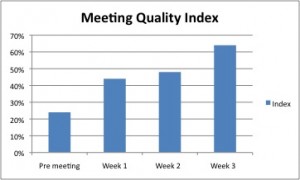A leading indicator for team performance: Chart your meeting quality
This is part of a series of posts designed to help break the mandatory meeting cycle. The better you make the meetings, the less you’ll need to make them mandatory. In my previous post, I described some basic criteria for what makes a meeting valuable and compelling to the attendees. With these criteria, you can start to measure the quality of your meetings or any meeting you attend.
After a meeting, it is often ambiguous whether the meeting was a success. The person calling the meeting may have obtained or shared the information they wanted to, but was it a compelling meeting?
Here are some ways to measure whether the meeting was compelling – for all participants. You can then chart this out and create an index over time to create a leading indicator index of meeting quality that you or your team members attend.
Before the meeting starts:
Survey (using email, SharePoint, post-it notes, or any other survey methods available to you) the attendees on the following criteria:
1) (Yes/No) I believe that the meeting attendees will bring value to me during the meeting
2) (Yes/No) I believe that I will bring some value to the meeting’s attendees
3) (Yes/No) I believe that the value of the meeting exceeds the value of the not attending the meeting and doing non-meeting work instead
4) (Yes/No) The meeting content and interaction makes my regular work unstuck, better, easier, more efficient, or compelling
5) (Yes/No) I believe that some change on my part will be required after the meeting
This survey can be done anonymously or with names attached. There are benefits to both: Anonymously gives you potentially more honest data. With names attached, you can follow up. Your call – you’ll get useful data either way.
With this data, you get a numeric view into the attitudes of the attendees, and can come up with some useful insights about the quality of the meeting, and the dynamics of it:
| Organizer | Attendee 2 | Attendee 3 | Attendee 4 | Attendee 5 | |
| Others bring value to me |
1 |
0 |
0 |
0 |
0 |
| I’ll bring value to others |
0 |
0 |
0 |
0 |
0 |
| Meeting value exceeds regular work |
1 |
0 |
0 |
0 |
0 |
| Meeting results makes my work better |
1 |
0 |
0 |
0 |
0 |
| Post-meeting change in my work |
0 |
1 |
0 |
1 |
1 |
The total score index for this meeting is a 6 out of a possible 25, or 24% index score. Clearly there’s room for improvement. Also, it appears that the meeting is unidirectional – the Organizer appears to be taking a lot away from the other attendees, but not creating value to the others. There is room for improvement. This is the “before” state of the meeting.
In analyzing the data, it looks like the post-meeting change is anticipated on the part of the participants, but they don’t seem to feel that there is any other value-add from the meeting, such as deriving any value from interacting with others, being able to improve how they do work together. Can the change be implemented such that it isn’t conveyed outside the meeting context? Perhaps the meeting should be altered to focus on how the change is going, rather than the announcement of the change?
The person calling the meeting (“Organizer”) can then adjust the way the meeting is run such that more of the criteria are met, or decide to cancel the meeting. Another obvious way to improve the meeting is to remove people who see no value in the meeting (such as Attendee 3 on the chart).
Armed with the pre-meeting score, the person calling the meeting can make adjustments to the meeting format. Then the meeting occurs, and the same survey can be performed post-meeting. If the post-meeting score improves from anticipated meeting score, the meeting exceeded expectations.
If this is a regular or “standing” meeting, you can track this index score over time:
You’ll be able to track whether your meetings are getting better or worse. You can adjust the format to experiment and see what changes. If the meeting stays well below 50%, then the meeting appears to be a net value detractor, rather than a value creator.
I recommend trying this individually—take a look at the meetings you attended last week. What score out of 5 did each meeting get? What is the average score? What can be done to improve this score?
This way of rating meetings is an easy and affordable way to create a leading indicator for the functioning of your team. Meetings are a crucial element of any team performance, and using this as a leading indicator will create higher team performance to your lagging indicators (on-time delivery, cost controls, sales, profits, etc.).
Do you have a way to rate the quality of the meetings? Does your even have a survey method to generate this data? Would you enjoy having a survey already created?
For you management designers out there, what tools and expectations do you provide to help meeting organizers understand the value of their meetings?
Related posts:
Nine simple tips to make meetings more compelling
Making it a mandatory meeting sabotages the meeting
More reasons mandatory meetings are bad for you and bad for your team
